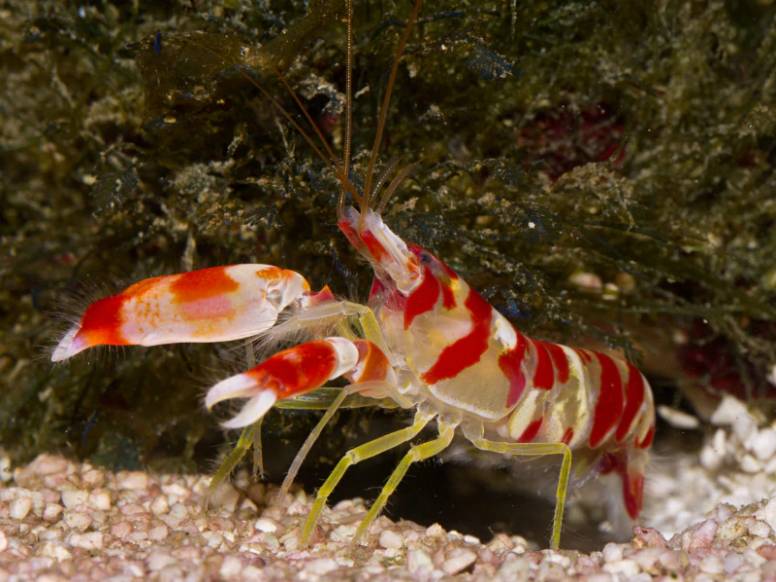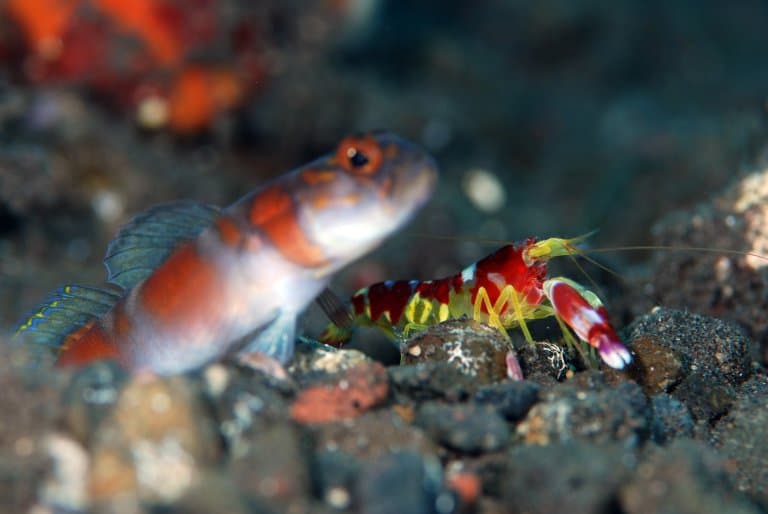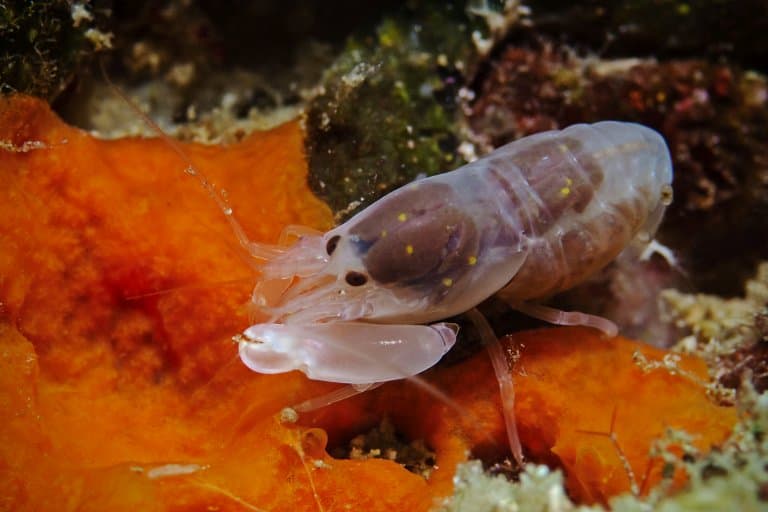Pistol Shrimp Profile
Crustaceans are hard. The ocean is such a brutal environment that they have to be. Unlike on land, there isn’t much space for plants to grow, so the majority of photosynthetic organisms are planktonic.
And most of those are eaten by other planktonic organisms, meaning pretty much everything else in the ocean is a predator.
So, to exist, let alone thrive, in the ocean means you have to be tough. And so, even the smallest of animals can pack a punch. Pistol shrimp are a good example of this, and they pack enough of a punch to kill small fish and deafen much larger ones.
Pistol shrimp also known as ‘alpheid shrimp’ are a family of true snapping shrimp, with asymmetrical claws that are capable of producing a loud snapping sound.

Pistol Shrimp Facts Overview
| Habitat: | Marine, reef |
| Location: | Worldwide |
| Lifespan: | Unknown |
| Size: | Usually up to 4cm |
| Weight: | 25 grams |
| Colour: | Varied, often translucent |
| Diet: | Hunters and scavengers of other sea creatures |
| Predators: | Wrasses, groupers, lionfish, trigger, and hawkfish |
| Top Speed: | Clapping speed of 100 km/h (62 mph) |
| No. of Species: | 1,119 |
| Conservation Status: | Varied |
There are over 1k species of pistol shrimp within 38 different genera that inhabit coral reefs and seagrass falts in marine waters and oceans worldwide.
Compared with the mantis shrimp, pistol shrimp tend to be overlooked. But while they can’t strip the flesh from your thumb, they can fire lightning and screw up your naval navigation tools.
Instead of excellent vision, they form alliances, or even colonies, and are known to work together, clicking their fingers to the rhythm of the sea.
And when they want to, they can really click!
Interesting Pistol Shrimp Facts
1. They’re not mantis shrimp
Mantis shrimp get much of the attention for being very pretty and also rather lethal, with their rapid-fire punches that serve a similar purpose to the pistol shrimp, but the two are very different animals.
Mantis shrimp are in a different order, the Stomatopods, and have their own unique quirks. Pistol shrimp diverged from this lineage over 300 million years ago, likely evolving their weapon of choice independently. 1
2. They can’t see too well
Some shrimp are well known for their incredible eyesight. The Mantis shrimp, also known for knocking fools out, has some of the best eyes in the animal kingdom. They can see in UV, they can see circularly polarised light, and they have 16 photoreceptors.
Pistol shrimp likely can’t do any of this. They’re thought to be poor-sighted and instead, some species make friends with the much larger and more visual goby fish, with whom they share a burrow. The two are like Master Blaster, with the large, lumbering gobi keeping an eye out for the smaller and more dangerous shrimp. 2
3. They can talk
Pistol shrimp didn’t fully understand Teddy Roosevelt’s famous West African proverb: “Speak softly and carry a big stick”; they’ve decided that the proverbial stick should speak for them, and they use it almost continuously.
When hunting, the powerful claw is deployed as an ambush weapon, but more commonly they’re used to communicate. And there’s nothing “softly” about it. 3
4. Their pistol claw measures over half the length of the shrimps body
Pistol shrimp are known for their disproportionately large claw on one of their arms.
Unlike most shrimp, it doesn’t have pincers at the end. It has two pistol-like parts, which a joint thtat allows the ‘hammer’ section to move backwards before it’s released and snaps into the other part of the claw.
This can emit a powerful wave bubble, enough to stun or even kill fish and break glass!
5. They compete to be the loudest animal in the ocean
In the shallow oceans, these tiny crustaceans are the loudest animals you’ll come across. Large colonies of these shrimp stay up all night and day, popping away, creating a deafening background noise that even interfered with the sonar of ships.
Until recently, it was thought to be the sound of the claw itself, but advancements in high-speed cameras have shown that there’s more to the mechanism than that. The giant claw closes so fast that it creates a partial vacuum, causing a bubble to be formed. The loud popping is created by the collapsing of this bubble of cavitation, moments after the claw has closed. 4
6. They bubble can reach speeds of of 25 m/s (90 km/h; 56 mph)
It’s no easy job to create a cavitation bubble with such a small appendage; the speeds involved are phenomenal. The sheer speed of the claw creates impact forces that can be thousands of times the shrimp’s body weight, sending high-velocity jets of water out from the claw itself.
This water jet can be sent out at tens of kilometres per hour – enough to stun or even kill small fish.

7. The snap can produce sonoluminescence
Pistol shrimp are the closest thing to a real-life Hadouken so far described in nature. Not only is there a highway-speed jet of water and a deafening cavitation bubble produced, but the energies involved heat the water to frightening levels.
Where the claw snaps shut, it leaves behind a space that the high-pressure ocean water rushes in to fill. The closing of this cavitation bubble releases huge amounts of energy and immense pressure, heating the tiny local space to temperatures of up to 4,800 degrees Celcius.
This creates a plasma arc, releasing a flash of light, seen on sensitive cameras, and essentially a high-pressure pulse of energy, directly into the body of unsuspecting victims.
8. They can regrow this tool
This epic weapon usually grows on one of the shrimp’s two front limbs. Many animals, especially crustaceans, are able to regrow lost limbs, but in the pistol shrimp, a lost pistol can regrow on the other arm!
This is very unusual, and so far, thought to be unique to these shrimp. 5

9. Some are eusocial
Another freakish quirk of this group of shrimps is the presence of eusociality in some species. Eusocial animals are ones for which the colony is everything. They sacrifice the majority of their independence to function as a tool for the greater hive organism, spawned usually by a single reproductive female.
Honeybees, ants, and many wasp species do this, but in shrimp, or even crustaceans as a whole, this isn’t usually a thing.
Synalpheus regalis lives in sponges in coral reefs, and spend their entire lives inside there. There can be over 300 shrimp in a colony, most of which never breed, and the group is supported by the reproductive efforts of a single queen.
There’s still quite a lot to figure out about the social structure of this species, and why it happens, but it’s the only example of eusociality in the ocean so far.

10. They have a ‘fortress defence’ strategy
The structure of the eusocial species’ colony appears to match the “Fortress Defence” archetype, defined by three conditions:
- A coincidence of food and shelter in an enclosed habitat,
- A high value of food-habitat resources that render inhabitants vulnerable to predation
- And the ability to defend these resources.
Almost all sponges are occupied by this species in their habitats, showing that they are high value, shared real estate, and specialised, non-breeding ‘soldiers’ stand guard to defend them with their Hadoukens when necessary.
Pistol Shrimp Fact-File Summary
Scientific Classification
| Kingdom: | Animalia |
| Phylum: | Arthropoda |
| Class: | Malacostraca |
| Order: | Decapoda |
| Suborder: | Pleocyemata |
| Infraorder: | Caridea |
| Superfamily: | Alpheoidea |
| Family: | Alpheidae |
Fact Sources & References
- Cara Van Der Wal (2017), “The evolutionary history of Stomatopoda (Crustacea: Malacostraca) inferred from molecular data”, PubMed Central.
- Phoevos Koukouvinis (2017), “Unveiling the physical mechanism behind pistol shrimp cavitation”, scientific reports.
- “Shrimp, bubble and pop”, BBC News.
- MICHEL VERSLUIS (2000), “How Snapping Shrimp Snap: Through Cavitating Bubbles”, Science.
- J.Emmett Duffy (1996), “Eusociality in a coral-reef shrimp”, nature.
